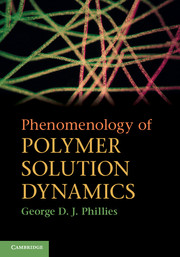Book contents
- Frontmatter
- Contents
- Preface
- 1 Introduction
- 2 Sedimentation
- 3 Electrophoresis
- 4 Quasielastic light scattering and diffusion
- 5 Solvent and small-molecule motion
- 6 Segmental diffusion
- 7 Dielectric relaxation and chain dimensions
- 8 Self- and tracer diffusion
- 9 Probe diffusion
- 10 Dynamics of colloids
- 11 The dynamic structure factor
- 12 Viscosity
- 13 Viscoelasticity
- 14 Nonlinear viscoelastic phenomena
- 15 Qualitative summary
- 16 Phenomenology
- 17 Afterword: hydrodynamic scaling model for polymer dynamics
- Index
- References
3 - Electrophoresis
Published online by Cambridge University Press: 05 August 2012
- Frontmatter
- Contents
- Preface
- 1 Introduction
- 2 Sedimentation
- 3 Electrophoresis
- 4 Quasielastic light scattering and diffusion
- 5 Solvent and small-molecule motion
- 6 Segmental diffusion
- 7 Dielectric relaxation and chain dimensions
- 8 Self- and tracer diffusion
- 9 Probe diffusion
- 10 Dynamics of colloids
- 11 The dynamic structure factor
- 12 Viscosity
- 13 Viscoelasticity
- 14 Nonlinear viscoelastic phenomena
- 15 Qualitative summary
- 16 Phenomenology
- 17 Afterword: hydrodynamic scaling model for polymer dynamics
- Index
- References
Summary
Introduction
The early electrophoresis experiments of Tiselius, first published in 1930, examined the motions of proteins in bulk solution as driven by an applied electrical field(1). In the original method, a mixture of proteins began at a fixed location. Under the infiuence of the field, different protein species migrated through solution at different speeds. In time, the separable species moved to distinct locations (“bands”). Electrophoresis is now a primary technique for biological separations(2, 3). Two improvements were critical to establishing the central importance of electrophoresis in biochemistry: First, thin cells and capillary tubes replaced bulk solutions. Second, gels and polymer solutions replaced the simple liquids used by Tiselius as support media. These two improvements greatly increased the resolution of an electrophoretic apparatus. Electrophoresis in true gels is a long-established experimental method. The use of polymer solutions as support media is more recent. An earlymotivation for their use was the suppression of convection, but electrophoretic media that enhance selectivity via physical or chemical interaction with migrating species are now an important biochemical tool.
Electrophoresis and sedimentation have a fundamental similarity: in each method, one observes how particular molecules move when an external force is applied to them. In sedimentation, the enhancement of buoyant forces by the ultracentrifuge causes macromolecules to settle or rise. In electrophoresis, the applied electrical field causes charged macromolecules to migrate. The experimental observable is the drift velocity of the probe as one changes the molecular weight and concentration of the matrix, the size or shape of the probe, or the strength of the external force.
- Type
- Chapter
- Information
- Phenomenology of Polymer Solution Dynamics , pp. 30 - 68Publisher: Cambridge University PressPrint publication year: 2011



